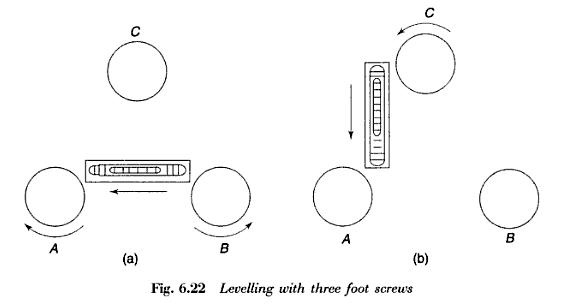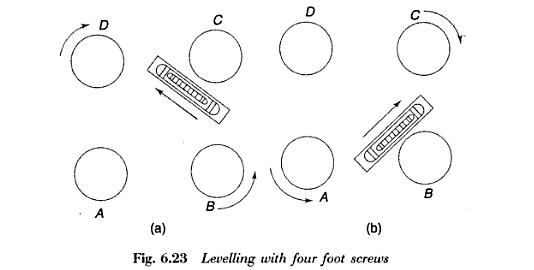Chapter: Civil Surveying : Levelling and Applications
Temporary Adjustment of a Surveying Level
Temporary Adjustment of a Level
At each set up of a level instrument,
temporary adjustment is required to be carried out prior to any staff
observation. It involves some well defined operations which are required to be
carried out in proper sequence.
The temporary adjustment of a dumpy
level consists of (1)Setting , (2)Leveling and (3) Focusing .
During Setting, the tripod
stand is set up at a convenient height having its head horizontal (through eye
estimation). The instrument is then fixed on the head by rotating the lower
part of the instrument with right hand and holding firmly the upper part with
left hand. Before fixing, the leveling screws are required to be brought in
between the tribrach and trivet. The bull's eye bubble (circular bubble), if
present, is then brought to the centre by adjusting the tripod legs.
Next, Leveling of the
instrument is done to make the vertical axis of the instrument truly vertical.
It is achieved by carrying out the following steps:
Step 1: The level tube is brought parallel to
any two of the foot screws, by rotating the upper part of the
instrument.
Step 2: The bubble is brought to the centre
of the level tube by rotating both the foot screws either inward or
outward. (The bubble moves in the same direction as the left thumb.)
Step 3: The level tube is then brought over
the third foot screw again by rotating the upper part of the instrument.
Step 4: The bubble is then again brought to
the centre of the level tube by rotating the third foot screw either
inward or outward.
Step 5: Repeat Step 1 by rotating the upper
part of the instrument in the same quadrant of the circle and then Step
2.
Step 6: Repeat Step 3 by rotating the upper
part of the instrument in the same quadrant of the circle and then Step
4.


Focusing is required to be done in order to
form image through objective lens at the plane of the diaphragm and to
view the clear image of the object through eye-piece. This is being carried out
by removing parallax by proper focusing of objective and eye-piece. For
focusing the eye-piece, the telescope is first pointed towards the sky.
Then the ring of eye-piece is turned either in or out until the cross-hairs are
seen sharp and distinct. Focusing of eye-piece depends on the vision of
observer and thus required whenever there is a change in observer.
For focusing the objective, the telescope is first pointed
towards the object. Then, the focusing screw is turned until the image
of the object appears clear and sharp and there is no relative movement between
the image and the cross-hairs. This is required to be done before taking any
observation.
Related Topics